1963 United States Grand Prix race report: Hill on top of the Glen as Surtees suffers again
Graham Hill is once more the beneficiary of others reliability problems as a near-certain victory for Ferrari's John Surtees slips from his grasp
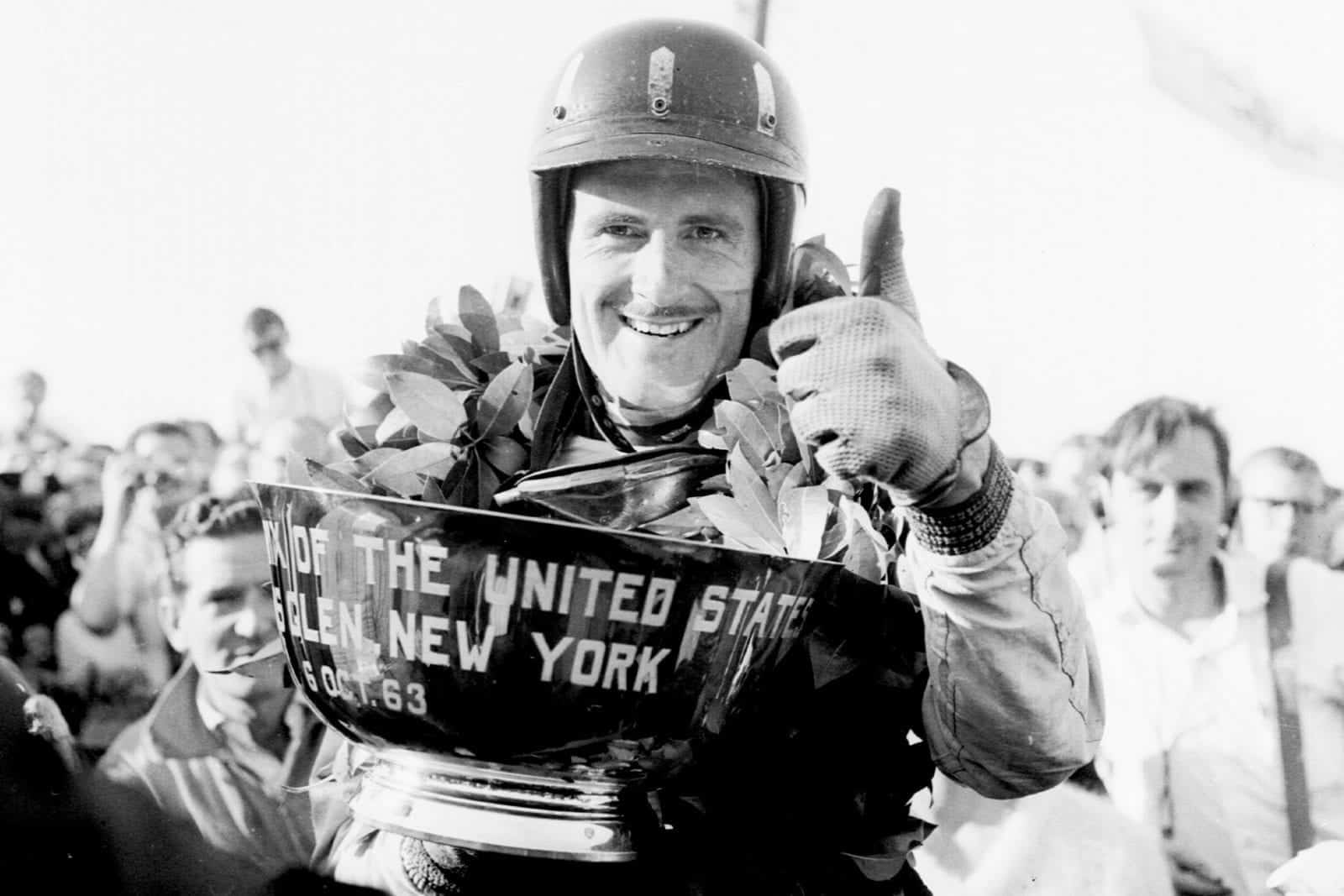
Graham Hill celebrates taking his second win of the season
Motorsport Images
The 1963 United States Grand Prix at Watkins Glen was freed this year from all World Championships considerations in so far that Clark and Lotus had clinched this year’s Championship at Monza. This race counted for itself only, and all outside considerations could be put aside.
The entry was the best yet as all teams with the exception of Scirocco were present. BRM had brought two old cars for Graham Hill and Ginther. Coopers had the same cars as raced at Monza, and the mountings for the removable radius arms were still there, although not used here. McLaren’s car had a flat crank engine, while Maggs‘ had a normal engine but an experimental dome over his inlet ports. The two Brabhams were as before, Jack Brabham’s car having a flat-crank engine while Gurney’s was the normal Coventry-Climax V8.
Lotus had three cars entered for Clark, Taylor and Pedro Rodriguez. The latest car with Hewland gearbox and flat-crank engine was for Taylor, while Clark was driving the older car which he had driven all season. Rodriguez was to drive the carburetter spare car.
Ferrari, contrary to all rumours, had turned up with the full team, a monocoque for Surtees and a normal car for Bandini, and a training car.
ATS had two cars for P Hill and Baghetti, the latter’s being the same as at Monza. Hill’s car had been modified, the gearbox now being behind the axle. This had been done by turning the whole gearbox axle unit around and putting a spacer between the engine and axle to keep the wheelbase the same without moving the engine back. Both cars had a short radius arm from the top link to the chassis halfway along the engine. This radius rod was approximately half the length of the lower one, and was as used at Monza.
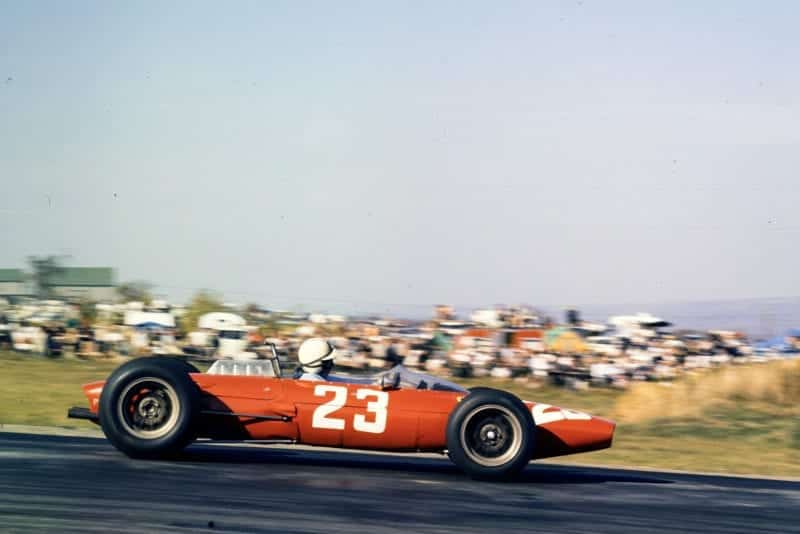
Ferrari were at Watkins Glen for the first time, entering Surtees (above) and Bandini
Motorsport Images
Reg Parnell had three cars, a Lola-Climax for Masten Gregory and two Lotus-BRMs for Roger Ward and Hap Sharp. Ward, a two-time winner at Indianapolis, was making his Formula One debut in a Formula One car. He ran a Midget car in the first US Grand Prix at Sebring but as this was a gimmick it couldn’t really count.
BRP had two entries but as Ireland is still in hospital following his crash last week at Seattle they only had one car, a Lotus-BRM for Jim Hall. The private entries which made up the rest consisted of the three regulars, Walker’s Cooper-Climax for Bonnier, de Beaufort’s Porsche and Siffert’s Lotus-BRM. The newcomer at this race was Peter Broeker from Canada driving a Stebro Mk IV. The Stebro is a FJ chassis with an ordinary twin Weber Ford 1,500cc engine and developing about 110bhp into which is fitted a Hewland gearbox. The chassis was of the multi-tubular type, the car being very low, and the driver was seated in a reclining position. Suspension was wide-based double wishbones at the front, while at the back there was a lower wishbone with a top link and radius arm. The small cast wheels were held on by four studs and as there was no centre hole on the wheel, Dunlops were unable to balance them.
“That some of the media information was inaccurate, eg. “World Champion Scotsman, red-headed Jimmy Clark…” didn’t alter the fact that F1 racing is catching on everywhere”
With such a good entry this year the papers, radio and TV were all giving more pre-race publicity than in previous years. That some of the information was inaccurate, eg, “World Champion Scotsman, red-headed Jimmy Clark…” didn’t alter the fact that F1 racing is catching on everywhere.
The Club had built a bit extra at the circuit each year, and for 1963 they had a Technical Building in which all the teams could work instead of towing the cars to garages after each practice. The shed, which was insulated, was bright both in daytime and at night, and sixteen cars and mechanics made good use of it. During practice it was only a short way to wheel the car to change ratios, stop oil leaks and carry out any other jobs which are difficult in the open and at the pits.
Qualifying
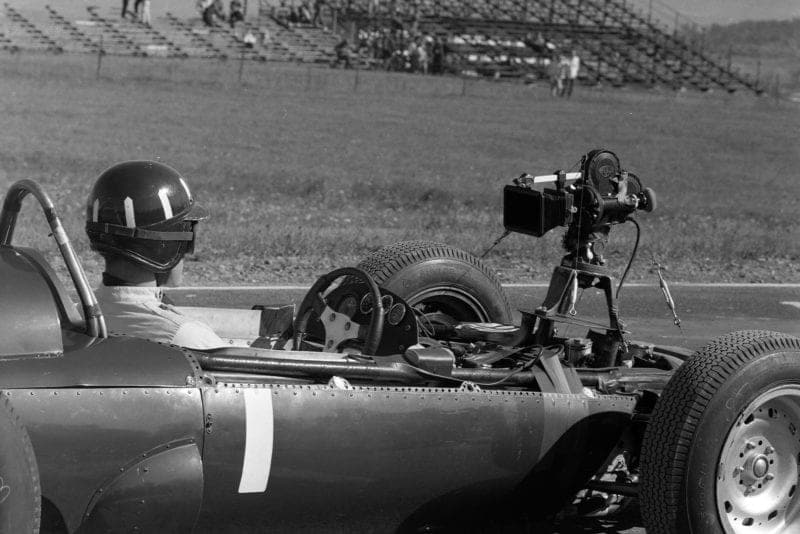
Hill finds himself on candid camera
Motorsport Images
Friday was very cold and local shops did a brisk trade in warm coats to the visiting teams. Practice started as it was planned, at 13:10hrs, after some drivers had driven round following McLaren who had a camera attached to his car. After the Nurburgring fiasco this seemed a little foolish, and when Graham Hill repeated this for someone else the next day it was obvious that racing drivers forget quickly.
Bandini was first out and Ward, Brabham and Clark followed immediately. ATS didn’t start very well and an oil plug blew out of the scavenge pump, covering the circuit with oil. The target was last year’s lap record, 1min 15sec, which was almost a second faster than the practice time. Graham Hill began to go fast and when he came into the pits both BRM’s were wheeled off to change gear ratios. Maggs and McLaren were soon under 1min 20sec when they had their ratios changed for this 3.22kms circuit.
The Lotus team seemed to have the right ratios from the start and within the first hour Clark had equalled his previous lap record. Gurney started off well and was soon down to 1min 15.5sec, and after this fast run it was found that there was water in the oil and the car was wheeled back to the Technical Building for repairs. Surtees was out in the monocoque Ferrari and very soon was down to 0.2sec of Gurney’s best.
In the first hour all, except Hap Sharp in the Lotus-BRM, did several laps. Sharp’s car had the gearbox off as the clutch was not withdrawing properly. De Beaufort had only done a warming-up lap when his Porsche’s crankshaft broke and he was on the ‘phone to New York to get a spare sent up immediately. Rodriguez had difficulty getting away in the third Lotus as he couldn’t disengage the clutch properly and therefore couldn’t get into first gear whilst stationary. Once the Mexican was moving he was soon down to 1min 20sec. Taylor, who now seemed quite recovered from his accident, got down to 1min 16.1sec before a camshaft broke, fortunately without doing too much damage.
The BRP car driven by Hall had been misfiring for some laps and when that was cured the Bendix pump packed up and had to be replaced. Siffert’s Lotus-BRM was going very well and he soon got down to 1min 18.4sec, when his engine went rough. As it was due for a change the car was wheeled away for the spare to be fitted. Roger Ward had the wires fall off the transistor box out on the circuit but he was able to put them back and returned to the pits. Ward’s times were improving steadily but when he was down to 1min 19.2sec a tooth on the main pressure oil pump broke and before he had noticed the loss of oil pressure the engine seized solid.
Graham Hill, Clark and Surtees were going very quickly and by half way through practice had shattered last year’s record and were down into the 1min 13sec bracket. Whilst trying hard, Hill’s BRM jumped out of gear on the far side of the circuit and he motored rapidly over the grass and into the trees, fortunately without hitting anything hard. On his return to the pits the mechanics began modifying the gate to stop this irritating trouble. Bonnier’s car was wheeled off before practice ended to have a wheel-bearing changed, the bearing having broken up over a period of some laps.
“Graham Hill, Clark and Surtees were going very quickly and by half way through practice had shattered last year’s record”
The Canadian Stebro dropped out very early on with oil leaking from the engine. The ATS was beginning to motor quite well, Phil Hill getting down to 1min 17.1sec and consistently getting into the 17sec. This was encouraging as previous times have not come near the faster cars.
As practice was coming to an end BRM, Lotus and Ferrari each sent out their No 1 driver to have a final “go.” The result of these last-minute laps and a slightly over-enthusiastic timekeeper gave Graham Hill the fastest lap of 1min 13.4sec, with Clark a tenth behind and Surtees a tenth behind again.
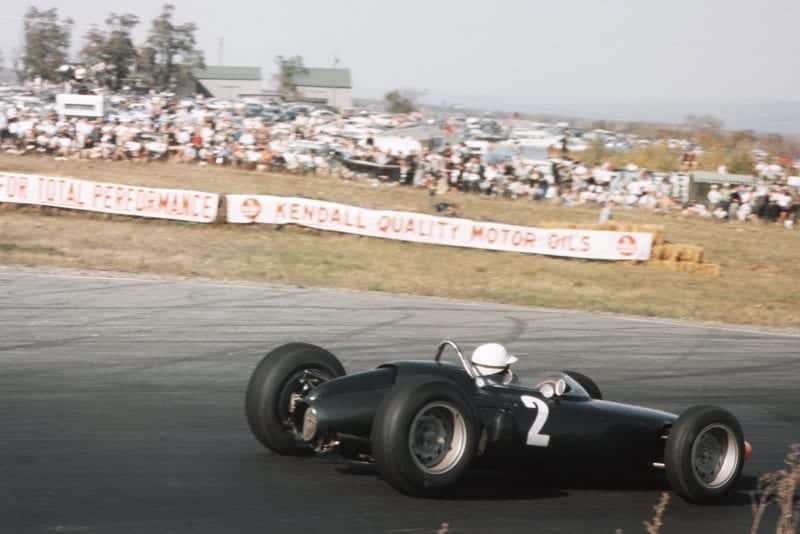
BRM’s Ginther puts in the laps, qualifying 4th
Motorsport Images
In the garage work started straight away getting the cars ready for the next five-hour practice session which was due to start at 11:00hrs next day. Lotus mechanics started repairing Taylor’s engine, using the camshaft from one of Parnell’s engines and an assortment of valves, all of which had to be ground to size. Clark’s gearbox was not functioning properly so it was being changed.
What was wrong at ATS was not easily definable as the mechanics were tearing both cars to pieces. In Hill’s car they rather foolishly fitted the experimental fuel injection engine for the next day. Second practice session was dry and warmer than the day before, and Clark, Graham Hill, Broeker, Hall, Rodriguez and P Hill were off as soon as the track was opened. Clark began trying hard from the start but it was Graham Hill in the 1962 car who was first down to 1min 14sec. After only a few laps it was noticed that Broeker was putting down a layer of oil, especially on the track in front of the pits. Several drivers complained and Bonnier, as President of the GPDA, with the Clerk of the Course asked Broeker not to go out again until he stopped dropping oil. Many drivers thought that as the car was not competitive and the driver not being up to their standards, that the organisers should not have accepted his entry.
So much oil had been spilt that practice stopped for half an hour while sweepers and cement were fetched to cope with the five to six hundred yards worst affected. When eventually the course was cleared of officials and official cars, practice resumed. After a few laps of fast driving, Surtees had the inboard rear right-hand lower wishbone mounting break. He slowed down to a crawl just over the brow of the hill; Bandini, in the second Ferrari, arrived, saw his teammate crawling along, so slowed up beside him to ask what was wrong.
At this moment Brabham and Ginther came over the brow flat out to find two cars side by side in the narrow road ahead. The BRM somehow squeezed past, but the Brabham, with all wheels locked up, rushed through the long grass and was very lucky not to hit anything. The damaged Ferrari was wheeled away and after a short while the practice car was brought out with Surtees’ proper number on it. Gurney was losing oil from a head of his engine and eventually Brabham decided to put in the spare he had with him. The engine troubles that the Brabham team are having this year seem to indicate poor preparation by Coventry-Climax.
The injection ATS engine was losing a lot of oil and Hill said he had no power at the top end, which was disappointing after the way he went the day before with the carburetter engine. Taylor’s Lotus was out of action for some time when a tab washer broke in the gearbox.
McLaren’s Cooper stopped practising when his oil pressure failed and in Maggs’ car a bearing in the gearbox started to break up just before practice ended. With half an hour extra added for the oil stop, practice finished at 15:30hrs. As the cars were driving away from the pits there was a blow-back in Taylor’s Lotus and a fire started in the inlet ports and V of the engine. Fortunately before it could get under way properly dust extinguishers soon had it out, leaving the car smattered in snow white dust.
“An unusual sight at the end of practice was to see a policeman with an Alsatian dog controlling everyone by letting the snarling dog leap at anyone near him!”
An unusual sight at the end of practice was to see a policeman with an Alsatian dog controlling everyone by letting the snarling dog leap at anyone near him and just holding him away so the fangs didn’t touch anyone! With a regulation which forbids dogs into race circuits it is obvious that the police in the USA are a dictatorial law unto themselves, as are the police in most countries. With much work to be done before the race, mechanics were working hard within minutes of practice ending.
BRMs were to lend Parnell their spare engine if they didn’t need it, and as Ginther’s and Hill’s cars were running well Roger Ward was all set for his first Grand Prix. Graham Hill’s time in first practice was still the fastest and he therefore occupied pole position with a speed of 112.81mph, a quite fantastic speed for this narrow bumpy circuit. As darkness settled over the circuit, fires and lamps began to light up as thousands of campers made ready for the night. The smell from hundreds of barbecues drifted over the local countryside.
Race
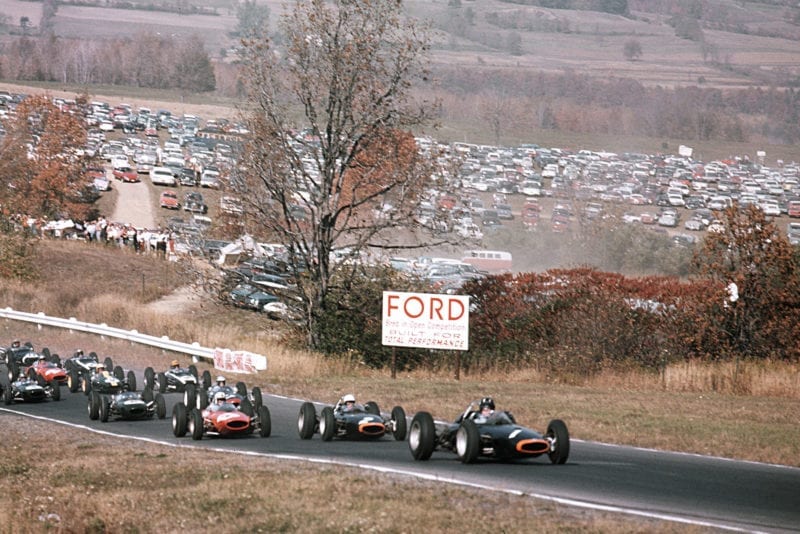
Hill leads the field at the start
Motorsport Images
Race day was clear and dry as the 14:00hrs start got nearer and the temperature went up into the 80s fine dust drifted from everywhere that cars and spectators moved. With pre-race parades and flags flying, cars lined up on the grid. Surtees was in the training car and it is that car’s time in the grid table. ATS had put the carburetter engine back into Hill’s car. At a minute to 14:00hrs the cars started up on the dummy grid and drove slowly forward to the starter. This was to stop any pile-up on the narrow circuit if a car stalled on the line. All the cars moved forward except Clark, who could get no sign of life from his Climax engine. Tex Hopkins, the starter, dropped the flag and Graham Hill streaked away from the front row of the grid with no Clark to beat him to the first corner.
Up the hill it was two BRMs close together followed by Surtees and Gurney. As the dust settled Baghetti was seen to be driving slowly, a long way behind. The ATS completed half a lap and then retired with a broken oil pump. The end of the first lap saw Graham Hill and Ginther leading and behind them, already beginning to string out, came Surtees, Gurney, Maggs, Gregory, Brabham, Taylor, Bandini, McLaren, Rodriguez, Bonnier, P Hill, Siffert, Hall, Ward, de Beaufort and Broeker. As the last car went past the pits completing its first lap, Clark’s Lotus burst into life.
The pressure fuel pump was playing up and when the engine would not fire Clark ran the battery flat trying. When a new battery was fitted the trouble seemed to cure itself and Clark started one and a bit laps down. At the front the leaders were beginning to form three groups. The first group of five consisted of Graham Hill, Ginther, Surtees, Gurney and Brabham, the latter passing Maggs into fifth place on the third lap. The second group consisted of Maggs with Rodriguez and McLaren pulling through from a mid-field first lap to get on to Maggs’ tail by the 10th lap. The third group which formed was Taylor, Bandini and Bonnier.
In the lead Hill’s BRM was just holding off Surtees who had passed Ginther into second place, but on the seventh lap the Ferrari surged past and tried to draw away. As the lead changed so did third and fourth places. Gurney passed Ginther and closed on to Graham Hill. On the 10th lap the Brabham slipped into second place and began to harass the Ferrari.
At the back of the field the second ATS was not happy and Phil Hill was forced to retire out on the circuit, also with broken oil pump, on his fifth lap. Two laps later Hap Sharp, who was lying 15th, also retired, with a broken tappet. The first five cars were still keeping close together. Hill stayed behind Gurney for seven laps, then passed into second position again, a lap before this Brabham displaced Ginther for fourth place, and for the next nine laps this group held these positions as they slipstreamed each other up the straight. On the 15th lap Masten Gregory brought the Lola-Climax into the pit with overheating and low oil pressure, and it was wheeled behind the pits to retire.
“Clark was beginning to cut through the tail-enders and by the 15th lap was in 14th position”
Clark was beginning to cut through the tail-enders and by the 15th lap was in 14th position. The Lotus was still not quite right and though some laps were very fast others were slower when the fuel pump was not working 100%. In the second group Rodriguez and McLaren were swapping positions while Maggs sat a few yards behind and watched. The third group were changing positions frequently until Taylor dropped out on the 25th lap with no sparks, due to transistor box failure. The other two, Bonnier and Bandini, pressed on in close company in ninth and 10th places.
The leaders had reached 30 laps when Hill closed right up on to Surtees and two laps later passed into first place. Next lap, Surtees had regained the lead. Hill had another “go” two laps later and again he took the lead for one lap before the faster Ferrari moved ahead again and Hill settled down to slipstreaming. Rodriguez in sixth place was comfortably leading the second group when a camshaft stopped turning, with disastrous results to the engine, and he was out on the 37th lap. Clark’s progress had brought him up to 11th place. Broeker who was driving round very slowly, was reported to be losing oil and his pit put out a board for him to come in, but the Canadian took no notice and ground slowly on to the end.
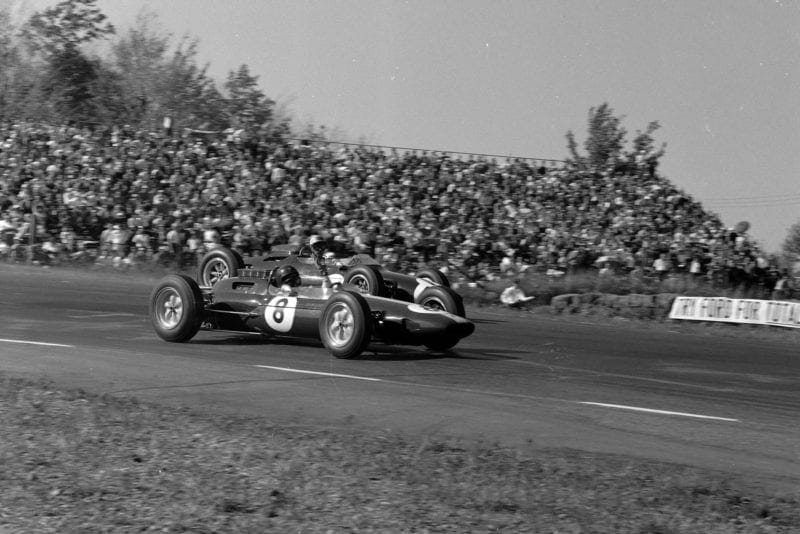
Clark passes Bonnier
Motorsport Images
By the 40th lap, Clark was on the tail of Bonnier and Bandini, and on the 43rd lap he passed both at once. So with Gurney retiring from third place on the same lap, with fuel starvation and cracked chassis, the No 1 Lotus driver was in seventh place. At the same time as Clark jumped forward three places, Ward stopped by the start line with a seized gear-shift and though he started off again the brute force of moving the lever had bent something, and on his 45th lap he retired.
Maggs, who had been following his team-mate, McLaren, for some laps, moved ahead when McLaren’s car began to slow with an obscure fuel-feed trouble, but his fifth place was short-lived for on his 45th lap he stopped with damaged engine after the timing slipped. Things were now settling down. Graham Hill had the short link from his rear anti-roll bar to the rear suspension fall off, which caused a sudden change in handling, and in the few minutes it took him to discover what was wrong he was out of the Ferrari slipstream and began to drop back lap by lap.
The BRM was understeering and Hill had to use the throttle a lot to keep the back round, which meant his driving looked a little ragged, with much dust and stone throwing as he kept dropping off the tarmac. Siffert retired on the 57th lap after running just over halfway through the field to this point. The reason for his retirement was an internal gearbox breakage. De Beaufort was running one from the end in his usual steady style and collecting a position with each retirement.
As the laps ticked away McLaren made two pit stops to try and correct the misfiring due to fuel starvation but after two attempts, which made no improvement, he retired. On the 76th lap, Bonnier, who had been lying sixth, came to the pits with a broken shock-absorber. The spindle had snapped off. The mechanics stripped off the spring and the broken parts and in a comparatively short time he was out again. While Bonnier was in the pits, Hall had vanished out on the circuit with a broken gearbox.
With thirty laps to go it seemed set for a Ferrari victory when Surtees suddenly came into the pits. The engine of his Ferrari had gone rough and its power had faded away. Graham Hill moved into the lead and Surtees’ car was wheeled away. The remaining laps slipped away and 2hr 19min 22.1sec after the flag dropped Graham Hill crossed the line to win the US Grand Prix at a speed of 176.879kph.
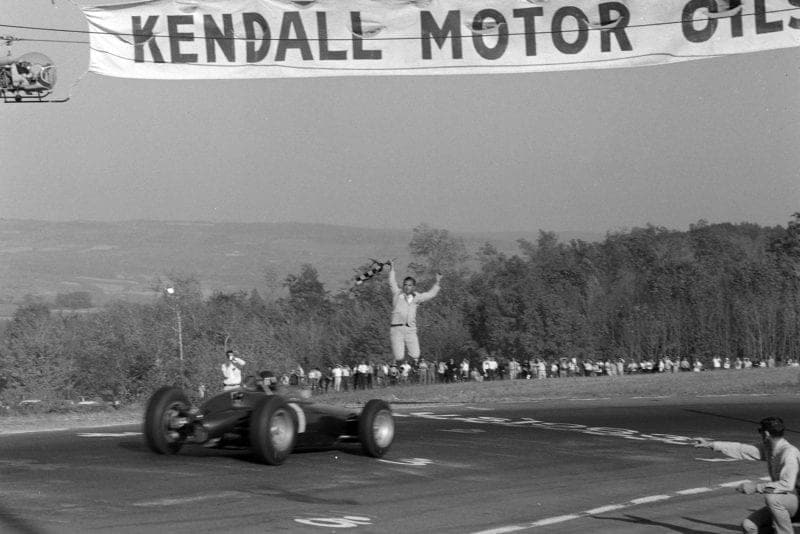
Hill takes the win
Motorsport Images
Behind Hill and on the same lap came his team-mate, Ginther, only 34sec behind. Next, a lap down, came Clark, who, with a misfiring engine, had driven a magnificent race. A lap down again came Brabham, whose car had also popped and banged for most of the race. Two laps down again came Bandini, fifth, haying completed ninety-nine of the hundred and ten laps, then de Beaufort, with Broeker seventh, eleven laps farther back. Bonnier came eighth and was the last of the runners at the end.
Surtees, Hall and McLaren, having completed 74 laps, were classified as finishers. The race held the interest of the large crowd to the very end, and Hill received a tremendous ovation from the spectators. The left-hand rear tyre of the BRM was completely bald at the end of the race due to the altered driving technique when the anti-roll bar broke.
Watkins waffles
- It appears that strong financial pressure is being brought on the organisation which sanctions the rendezvous of the US Grand Prix, to move the race elsewhere in 1965. Unless the Club which is trying to get the race knows something about this type of racing there could easily be a repetition of the badly-run Grands Prix of 1959 and 1960. For three years Watkins Glen organisation has run the Grand Prix of the United States without any drama and in a very friendly way. Most drivers, mechanics and the Press will be sorry to see such a move.
- It is very rare to find a race commentator who knows his facts, and it is even rarer to find one who you couldn’t fault in some factor or other. The reason for the phenomena was that Stirling Moss was giving the factual commentary on the cars and drivers. The European organisers could improve their English commentaries by asking Stirling to oblige.
